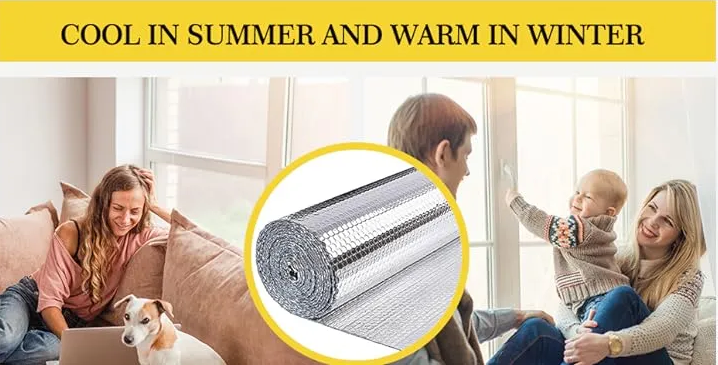
Is Bubble Wrap Good Insulation? How to Install it?
You can make bubble wrap work both to protect your shipments and help keep your spaces warmer. This guide answers the question: “Is bubble wrap good insulation?” and explains how to use it effectively. With benefits like energy savings and easy installation, bubble wrap is a suitable option for your insulating needs.
The Science Behind Bubble Wrap Insulation
To understand bubble wrap’s insulation quality, you must understand its operating principle. Each air-filled space in bubble wrap forms a separator that prevents heat from flowing through on both sides. Bubbles in the material maintain pockets of air that stop both heat flow from within and heat flow from outside the space. Your home temperatures stay easier to control when you put bubble wrap insulation around it.
Bubble wrap insulation helps keep buildings at a stable temperature, so homeowners need fewer energy systems to heat or cool their space. During each month the insulation saves you money on your energy bills. To maximize these benefits, the installation must be done correctly to ensure air pockets are maintained. Proper application guarantees optimal performance, allowing you to enjoy a comfortable living space while saving money.
See also: Understanding Transportation for Your Business Needs
Is Bubble Wrap Good Insulation?
Before deciding, “Is bubble wrap good insulation?” it’s important to consider several factors to understand its effectiveness in insulation.
Application Scenarios
Bubble wrap works well as insulation throughout different environmental conditions. The insulation power of bubble wrap shows up most when you place it on windows to keep heat inside during winter. Putting bubble wrap over windows improves their insulation quality and makes a straightforward difference in room temperature control. In warmer regions, bubble wrap creates a natural barrier against heat that lets you keep your space comfortable without relying heavily on air conditioners.
However, bubble wrap is not recommended as a primary insulation method for large areas. While it works well for quick fixes and temporary installations, specialized materials, such as reflective bubble insulation, generally offer better long-term thermal performance for walls and ceilings. Reflective bubble insulation offers superior thermal performance, making it a great solution for keeping your entire space energy-efficient and comfortable.
How to Use Bubble Wrap as Insulation
Setting up bubble wrap insulation follows easy steps. These steps explain how you should use bubble wrap to increase insulation in your house.
Installation Tips
You should begin by measuring the areas you need to protect before continuing with installation. Make bubble wrap pieces to match your desired dimensions with small edges that overlap on each side. For windows, lightly mist the glass with water to help the bubble side adhere. Press the bubble wrap onto the wet surface, ensuring the bubbles face the window. You can install bubble wrap insulation on your own using an easy process that gives you professional-quality insulation.
For better results, use insulation double bubble for added thermal protection. It’s specifically designed to enhance energy efficiency and can yield even greater results when used on large surfaces or multiple layers.
Maintenance and Removal
Maintaining bubble wrap insulation is simple. Look at your bubble pack every day for signs that parts are corroded or breaking down. Replace the tarps when their adhesive power weakens or decayed. The bubble wrap lifts off the surface easily without hurting the surface beneath it.
Given its lightweight nature, bubble wrap can be reused if carefully handled. If you decide to switch to another insulation type or take it out for the season, bubble wrap can be stored for future use or recycling, providing more value to your investment.
Final Thoughts on Bubble Wrap Insulation and Explore Insulation Marketplace
When properly used, bubble wrap serves well as insulation due to its energy-saving abilities and fast application. You can rely on bubble wrap for both permanent and temporary window insulation projects. Check out the wide range of insulation materials that you can use as a permanent solution. Check out Insulation MarketPlace to find quality products like reflective bubble insulation and enhance your home’s energy efficiency.
FAQs about Bubble Wrap and Insulation
Can bubble wrap improve my home’s energy efficiency?
Yes, bubble wrap can enhance energy efficiency by reducing heat loss or gain, especially when used on windows.
Is bubble wrap suitable for all types of insulation?
No, while bubble wrap can work in specific scenarios, it is not a long-term solution for large areas of insulation.
However, bubble core reflective insulation, a more advanced version of bubble wrap, can be a suitable option for many areas. This type of insulation combines the reflective properties of aluminum with the bubble core design, creating a barrier that helps reduce heat transfer while also offering moisture control. It’s ideal for use in attics, walls, basements, and garages, providing an efficient and lightweight solution that can be easily installed in both residential and commercial buildings.
For optimal results, especially in large-scale applications, it’s better to consider bubble core reflective insulation over traditional bubble wrap.
How long does bubble wrap insulation last?
Bubble wrap insulation can last for several seasons if applied correctly and protected from wear and tear. However, regular checks for damage are advisable to maintain its effectiveness.




